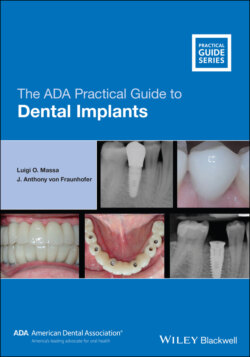Читать книгу The ADA Practical Guide to Dental Implants - J. Anthony von Fraunhofer - Страница 14
Implants for Single Crowns and Bridgework
ОглавлениеAs stated above, 178 million people in the U.S. are missing at least one tooth [11]. Before the use of dental implants, fixed partial dentures (bridges) or RPDs were utilized. One major problem with these treatment modalities is that fewer teeth are taking the load. For example, in the case of a four‐unit fixed bridge, only two teeth are carrying the load of the four teeth it restores because the pontics provide no functional support.
Figure 1.3 Implant‐supported overdenture.
Source: Courtesy of Zest Anchor.
The advantages for placing an implant and restoring it to replace a missing, free‐standing tooth are summarized in Table 1.2.
Table 1.2 Advantages of implants replacing individual teeth.
| No unnecessary preparation of adjacent teeth for a traditional bridge Long‐term prognosis better than for a traditional bridge [13, 14] Long‐term cost is less than for a traditional bridge Significantly better retention of prostheses, including RPD's In the authors' opinion, ease of dental hygiene is improved with implants as opposed to a traditional bridge Greater long‐term patient satisfaction |
Dentists are accustomed to replacing multiple missing teeth with a RPD. In fact, RPDs have been a viable treatment option for decades. While they serve a recognizable and useful purpose, they do require some skill and much experience in regard to their design and fabrication.
Despite their many advantages, which include relatively low cost, RPDs have some major drawbacks. In particular, they can lead to increased ridge resorption, especially with appliances fabricated with non‐metallic bases, i.e., what are commonly known as “flippers.”
Whereas RPDs with polymeric (usually acrylic) clasps are somewhat “kinder” to supporting teeth, metallic clasps and rests will commonly traumatize the clasped teeth over time, notably causing wear and abrasion. This destructive action is due to clasps riding up and down the anchor teeth due to flexure of the RPD during mastication or parafunctional activities. Poor fit and/or repetitive vertical (and lateral) movements due to cyclic loading will not only exacerbate wear and abrasion of the abutment teeth but increase ridge resorption.
Another problem with RPDs, especially those with polymeric bases and poorly‐fitting appliances, is that food particles may often be trapped beneath the denture. This can lead to mucosal irritation, periodontal problems and, possibly, to decay of the supporting teeth. Further, staining of the acrylic “gum work” of the RPD as well as odor necessitates repeated and careful cleaning of the RPD on at least a daily basis to ensure a hygienic appliance and absence of halitosis. Depending upon diet and beverage consumption as well as smoking, there is often the need for more frequent cleaning of the RPD. Failure to remove the RPD and clean teeth and RPD separately compromises effective hygiene of both teeth and RPD.
There are, of course, some disadvantages to the use of implants to replace multiple teeth, Table 1.3.
Table 1.3 Disadvantages of implants vs traditional bridgework and RPDs.
| Short‐term cost is higher than for a traditional bridge or RPD Surgery is required Generally, treatment time is longer – 4–8 months. |
